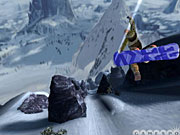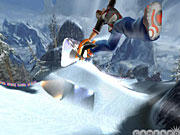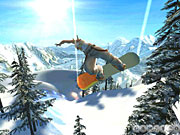SSX 3 Q&A
We talk to the series' creator about the past, present, and future of SSX.
We recently talked to Steven Rechtschaffner, studio vice president and Electronic Arts Vancouver and executive producer of SSX, about where the SSX franchise has been and where it's going.
GameSpot: Where did the inspiration for SSX come from?
Steven Rechtschaffner: I've been a snowboarder for a long time, I would say about 18 or 19 years, and when the idea originally came I was working on Triple Play Baseball. I was thinking about how to bring snowboarding to life in a video game. What it came down to was just making a simulation that felt like you were really able to snowboard. And then creating a sense of open environments so you were able to find your way down the mountain and explore while you went. We also wanted something that really felt visually stunning, because that's what you experience when you go up on the mountain--it just looks better than the rest of the world.
GS: What reaction did you get when you presented the idea?
SR: When I first put the idea of SSX on the table, it did not [win everyone's] support. It was really by no fault of those people, it was really how I was presenting it. What I would say to people was, "Yes this is a snowboarding game but...but it's not a snowboarding game!" While my intention was right--my intention was always to make a snowboarding game with the team that would appeal to people who snowboard, as well as to people who didn't snowboard--I didn't want to make a simulation. [I didn't want to have] a bunch of pro riders in [the game] that snowboarders knew and non-snowboarders didn't and basically present snowboarding as it exists today. The whole idea was to use this as a launching pad for a new brand, which ended up being the EA Big brand, and to be able to mix simulation with what we said was stimulation.
So, create a foundation that was believable, so you really felt like you were snowboarding, and then do things that were plausible but not likely. So the whole time I'm talking about "Yeah, it's a snowboard game but it's not a snowboard game," all I succeeded in doing was just really confusing people. So, in the end, somebody gave me some good advice and just said, "Say you're gonna make the best snowboarding game and here's the reasons why it's going to be better..."
GS: How did you settle on a platform?
SR: We started out with a whole bunch of ideas and we started prototyping physics. This was originally in the days of the PlayStation, Dreamcast, and N64. What we quickly came to realize was that there wasn't even enough horsepower to run the physics engine, let alone all the rendering and everything else we wanted to do. So we stepped back and said, "Let's not compromise what we want to build, let's aim for the PlayStation 2," which at that point hadn't been publicly announced [or had its] technical information [published]. We actually launched with the PlayStation 2 in Japan, so we were out before the PlayStation 2 even launched in North America. But the company saw how the game was coming together, and the grand frommages at EA said, "This really has a lot of potential."
GS: How did SSX Tricky come about?
SR: We launched the original SSX day one with the PlayStation 2 and we had that Christmas to sell the game. It was very successful, but there was a very small installed base of PlayStation 2s to sell to. So it was coming toward the next Christmas, where we were thinking, "How do we not get SSX buried?" Because everybody was going to be excited about the new titles and nobody was going to be thinking about a title that shipped 15 months ago. We thought, "Let's go back and do something." Originally the idea started out as kind of a director's cut modeled on the DVD model. We thought, "Let's do some things that weren't in the original one." That's really where it started, and then as we got the team fired up about it, people started saying, "We could do more, we could do more. We can do some new courses and we can go back and refit the old courses. We can add new characters. Let's get some cool actors to be the voices for the characters." And it just got bigger and bigger and bigger, so it went from being a director's cut to kind of its own thing.
And, with the introduction of the uber tricks, we were going back and using the same courses that we raced on but putting in new objects for jumping and rail grinds. We were really building up the trick experience--that's how the name came to be. I'm a huge fan of old-school hip-hop, having lived through it and grown up with it in New York. I was listening to an old mix tape, and there was "Tricky," and I thought, "There's the name, there's the song, there's the whole full meal." So Tricky was really an opportunistic way, in the second Christmas of the PlayStation 2, to offer people something that was more than the original SSX. It was not really intended for the people who bought SSX. It was intended more for the expanding PlayStation 2 audience, as well as the other platforms--we went out on the GameCube and Xbox--to allow those people to experience SSX. As it turned out, we're into the millions of units sold on that. People who had the original game came back and bought [Tricky] too. It was really more of an evolution than a revolution.
GS: Was there anything you'd planned for the games that didn't make it in?
SR: One of the things that we'd planned for both SSX and Tricky that we ended up pulling out was an adventure experience. It was always the third leg of our tripod--you had racing, you had tricks, and we'd always imagined a third leg, which was adventure, where we gave people a reason to go around the mountain and explore, besides racing and doing tricks. Because if you're racing, you're always looking for the fastest line, and if you're doing tricks, you're always looking for the biggest hits or the coolest rails or the best areas to do combinations in. It's something that we've spent a lot of time working on for SSX 3.
GS: Speaking of SSX 3, where are you looking for inspiration for that game?
SR: A big piece of inspiration for SSX 3 was being up [Snow-Cat] boarding at Island Lake Lodge. We were going up in the [Snow-Cat], we're about two-thirds of the way up, and there were just all these bowls and huge shoots and we were just looking at it trying to imagine, "Where can we ride? Where can we go? What can we do next?" I realized that if we could deliver that in our next game, the feeling of being on a mountain and seeing areas and thinking, "Is that rideable over there? Can I go over there?" or, "I wonder if there's a race course over there."
So we created these three huge peaks. I don't want to give too much away too early on, but it's different in how you experience the game, as well as what you experience. Because you're able to race again--we've really blown that out, it's just more fun, more believable. Yet [there's also] more of the top-slope style, where you're doing tricks. But it's not just about doing tricks, it's about trying to find the best line through and figuring out how to combine your tricks to keep a combo going. Wider-slope-style courses that have, at any given point, eight to 12 different paths to find your way down. There's also big air--we have these courses that are short experiences, most of them are 40 to 60 seconds long, and there are multiple jumps in them. You have to find the best line down through them to find the best jumps and do the best tricks. There are also super pipes, which are just ways to express yourself on these big, over-the-top, connected half-pipes. There are also challenges and collectibles to find--there's all kinds of new stuff in there. I think, if you're an SSX player from the past, you'll come into this world and go, "Wow, I better set some time aside in my calendar, because I'm going to be doing this for a while."
GS: What can you tell us about the online components in SSX 3?
SR: Taking SSX online has always been looked at as a big opportunity for us. We thought it would be a way to be able to allow you to play against other people, but be able to be full screen on your own system. It's fun racing head-to-head on a split screen, but it's not the same experience as playing full screen. So the starting point for playing online was that simple: just be able to play against other people in full screen. From there, as we started developing all these other modes and ways of playing the game. We thought, "It would be fun to be able to do all these."
So that's really what we've been striving for--the ability to play all the different ways you can play offline online, and be able to do it in a way that can be figured out by anyone. A big thing about SSX and all Big games is that they're games that anyone can pick up and play and figure out how to get into. In SSX 3, you may be surprised when you first see it, because there's virtually no front end to it. It opens up and you're asked to make one selection and then it thrusts you into the game. You're playing the game before you realize it. We're always striving, ironically, not for more complexity but for more simplicity. Even though it's complicated beneath the surface, hopefully it's really simple on the surface.
GS: Thanks for your time.
Got a news tip or want to contact us directly? Email news@gamespot.com




Join the conversation